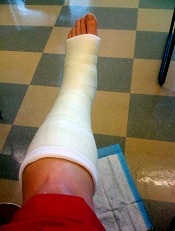
Photo by Nikki McLeod
Researchers say they have developed prediction models and a scoring system that can help identify a high risk of venous thromboembolism (VTE) in a patient who has a plaster leg cast.
The group utilized data from 3 large studies to develop and validate 3 prediction models and a risk score, known as the L-TRiP (cast) score, which are intended to help doctors decide whether patients with casts require thromboprophylaxis.
The models and the scoring system all predicted VTE with fairly high accuracy, but the researchers said this study had 2 major limitations.
First, due to the retrospective nature of the study, the team was unable to determine which of the patients may have received thromboprophylaxis. And second, blood samples were taken 3 months after VTE.
Banne Nemeth, MD, of Leiden University Medical Center in Leiden, Netherlands, and colleagues conducted this research and reported the results in PLOS Medicine.
Developing prediction tools
The researchers first analyzed data from the MEGA study, a population-based, case-control study in the Netherlands that included 4446 patients with VTE and 6118 controls.
From these data, the team attempted to identify biomarkers, genetic factors, and environmental factors predictive of VTE and build 3 different prediction models. Their full prediction model consists of 32 predictors for VTE, including 3 genetic factors and 6 biomarkers.
Their restricted model consists of 11 predictors for VTE, including 2 genetic factors and 1 biomarker. And their clinical model consists of 14 environmental predictors that can all be determined without drawing blood or performing any laboratory assays.
The predictors in the clinical model were given numerical values that, when summed, produce the L-TRiP (cast) score (Leiden–Thrombosis Risk Prediction for patients with cast immobilization score) to stratify patients into high- or low-risk groups for VTE.
To determine the discriminatory power of the models and the score in patients with casts, the researchers calculated the area under the curve (AUC) for each tool.
The AUC was 0.85 for the full model, 0.84 for the restricted model, 0.77 for the clinical model, and 0.76 for the L-TRiP (cast) score.
Validating the tools
The researchers validated the prediction models and risk score in 2 independent cohorts, THE-VTE study (784 VTE cases and 523 controls from the Netherlands and the UK) and the Milan study (2117 cases and 2088 controls from Italy).
In THE-VTE study, the AUC was 0.75 for the clinical model and 0.77 for the L-TRiP (cast) score. (There were no data provided for the full model or the restricted model in this cohort.)
In the Milan study, the AUC was 0.93 for the full model, 0.92 for the restricted model, 0.96 for the clinical model, and 0.95 for the L-TRiP (cast) score.
The researchers said these results suggest that genetic and biomarker information may provide added value in predicting VTE.
However, their clinical model (which consists solely of environmental factors) proved only slightly inferior to the full model in the derivation cohort and performed as well or better than the full model in the validation cohorts.
So it is unclear whether genetic and biomarker information will lead to higher accuracy in the prediction algorithm.


